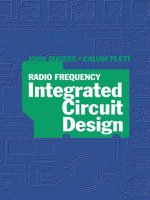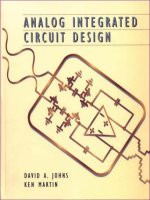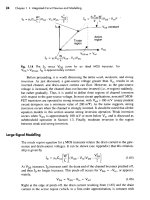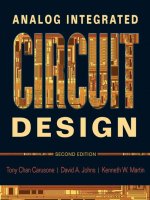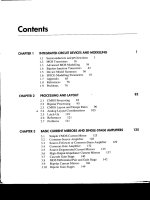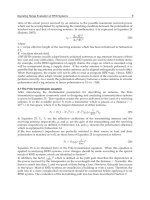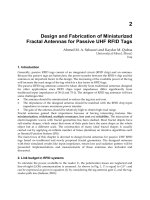Ebook - Radio frequency integrated circuit design
Bạn đang xem bản rút gọn của tài liệu. Xem và tải ngay bản đầy đủ của tài liệu tại đây (9.21 MB, 431 trang )
Radio Frequency Integrated Circuit Design
For a listing of recent titles in the Artech House Microwave Library,
turn to the back of this book.
Radio Frequency Integrated Circuit Design
John Rogers
Calvin Plett
Artech House
Boston
•
London
www.artechhouse.com
Library of Congress Cataloging-in-Publication Data
Rogers, John (John W. M.)
Radio frequency integrated circuit design / John Rogers, Calvin Plett.
p. cm. — (Artech House microwave library)
Includes bibliographical references and index.
ISBN 1-58053-502-x (alk. paper)
1. Radio frequency integrated circuits—Design and construction. 2. Very high speed
integrated circuits. I. Plett, Calvin. II. Title. III. Series.
TK7874.78.R64 2003
621.3845—dc21 2003041891
British Library Cataloguing in Publication Data
Rogers, John
Radio frequency integrated circuit design. — (Artech House microwave library)
1. Radio circuits—Design and construction 2. Linear integrated circuits—Design and
construction 3. Microwave integrated circuits—Design and construction
4. Bipolar integrated circuits—Design and construction I. Title II. Plett, Calvin
621.3’812
ISBN 1-58053-502-x
Cover design by Igor Valdman
2003 ARTECH HOUSE, INC.
685 Canton Street
Norwood, MA 02062
All rights reserved. Printed and bound in the United States of America. No part of this book
may be reproduced or utilized in any form or by any means, electronic or mechanical, including
photocopying, recording, or by any information storage and retrieval system, without permission
in writing from the publisher.
All terms mentioned in this book that are known to be trademarks or service marks have been
appropriately capitalized. Artech House cannot attest to the accuracy of this information. Use
of a term in this book should not be regarded as affecting the validity of any trademark or service
mark.
International Standard Book Number: 1-58053-502-x
Library of Congress Catalog Card Number: 2003041891
10987654321
Contents
Foreword xv
Acknowledgments xix
1 Introduction to Communications Circuits 1
1.1 Introduction 1
1.2 Lower Frequency Analog Design and Microwave
Design Versus Radio Frequency Integrated
Circuit Design 2
1.2.1 Impedance Levels for Microwave and Low-
Frequency Analog Design 2
1.2.2 Units for Microwave and Low-Frequency Analog
Design 3
1.3 Radio Frequency Integrated Circuits Used in a
Communications Transceiver 4
1.4 Overview 6
References 6
2 Issues in RFIC Design, Noise, Linearity, and
Filtering 9
2.1 Introduction 9
v
vi Radio Frequency Integrated Circuit Design
2.2 Noise 9
2.2.1 Thermal Noise 10
2.2.2 Available Noise Power 11
2.2.3 Available Power from Antenna 11
2.2.4 The Concept of Noise Figure 13
2.2.5 The Noise Figure of an Amplifier Circuit 14
2.2.6 The Noise Figure of Components in Series 16
2.3 Linearity and Distortion in RF Circuits 23
2.3.1 Power Series Expansion 23
2.3.2 Third-Order Intercept Point 27
2.3.3 Second-Order Intercept Point 29
2.3.4 The 1-dB Compression Point 30
2.3.5 Relationships Between 1-dB Compression and
IP3 Points 31
2.3.6 Broadband Measures of Linearity 32
2.4 Dynamic Range 35
2.5 Filtering Issues 37
2.5.1 Image Signals and Image Reject Filtering 37
2.5.2 Blockers and Blocker Filtering 39
References 41
Selected Bibliography 42
3 A Brief Review of Technology 43
3.1 Introduction 43
3.2 Bipolar Transistor Description 43
3.3

Current Dependence 46
3.4 Small-Signal Model 47
3.5 Small-Signal Parameters 48
3.6 High-Frequency Effects 49
3.6.1 f
T
as a Function of Current 51
3.7 Noise in Bipolar Transistors 53
3.7.1 Thermal Noise in Transistor Components 53
3.7.2 Shot Noise 53
3.7.3 1/f Noise 54
vii
Contents
3.8 Base Shot Noise Discussion 55
3.9 Noise Sources in the Transistor Model 55
3.10 Bipolar Transistor Design Considerations 56
3.11 CMOS Transistors 57
3.11.1 NMOS 58
3.11.2 PMOS 58
3.11.3 CMOS Small-Signal Model Including Noise 58
3.11.4 CMOS Square Law Equations 60
References 61
4 Impedance Matching 63
4.1 Introduction 63
4.2 Review of the Smith Chart 66
4.3 Impedance Matching 69
4.4 Conversions Between Series and Parallel Resistor-
Inductor and Resistor-Capacitor Circuits 74
4.5 Tapped Capacitors and Inductors 76
4.6 The Concept of Mutual Inductance 78
4.7 Matching Using Transformers 81
4.8 Tuning a Transformer 82
4.9 The Bandwidth of an Impedance Transformation
Network 83
4.10 Quality Factor of an LC Resonator 85
4.11 Transmission Lines 88
4.12 S, Y, and Z Parameters 89
References 93
5 The Use and Design of Passive Circuit
Elements in IC Technologies 95
5.1 Introduction 95
5.2 The Technology Back End and Metallization in
IC Technologies 95
viii Radio Frequency Integrated Circuit Design
5.3 Sheet Resistance and the Skin Effect 97
5.4 Parasitic Capacitance 100
5.5 Parasitic Inductance 101
5.6 Current Handling in Metal Lines 102
5.7 Poly Resistors and Diffusion Resistors 103
5.8 Metal-Insulator-Metal Capacitors and Poly
Capacitors 103
5.9 Applications of On-Chip Spiral Inductors and
Transformers 104
5.10 Design of Inductors and Transformers 106
5.11 Some Basic Lumped Models for Inductors 108
5.12 Calculating the Inductance of Spirals 110
5.13 Self-Resonance of Inductors 110
5.14 The Quality Factor of an Inductor 111
5.15 Characterization of an Inductor 115
5.16 Some Notes About the Proper Use of Inductors 117
5.17 Layout of Spiral Inductors 119
5.18 Isolating the Inductor 121
5.19 The Use of Slotted Ground Shields and
Inductors 122
5.20 Basic Transformer Layouts in IC Technologies 122
5.21 Multilevel Inductors 124
5.22 Characterizing Transformers for Use in ICs 127
5.23 On-Chip Transmission Lines 129
5.23.1 Effect of Transmission Line 130
5.23.2 Transmission Line Examples 131
5.24 High-Frequency Measurement of On-Chip
Passives and Some Common De-Embedding
Techniques 134
ix
Contents
5.25 Packaging 135
5.25.1 Other Packaging Techniques 138
References 139
6 LNA Design 141
6.1 Introduction and Basic Amplifiers 141
6.1.1 Common-Emitter Amplifier (Driver) 141
6.1.2 Simplified Expressions for Widely Separated
Poles 146
6.1.3 The Common-Base Amplifier (Cascode) 146
6.1.4 The Common-Collector Amplifier (Emitter
Follower) 148
6.2 Amplifiers with Feedback 152
6.2.1 Common-Emitter with Series Feedback (Emitter
Degeneration) 152
6.2.2 The Common-Emitter with Shunt Feedback 154
6.3 Noise in Amplifiers 158
6.3.1 Input-Referred Noise Model of the Bipolar
Transistor 159
6.3.2 Noise Figure of the Common-Emitter Amplifier 161
6.3.3 Input Matching of LNAs for Low Noise 163
6.3.4 Relationship Between Noise Figure and Bias
Current 169
6.3.5 Effect of the Cascode on Noise Figure 170
6.3.6 Noise in the Common-Collector Amplifier 171
6.4 Linearity in Amplifiers 172
6.4.1 Exponential Nonlinearity in the Bipolar
Transistor 172
6.4.2 Nonlinearity in the Output Impedance of the
Bipolar Transistor 180
6.4.3 High-Frequency Nonlinearity in the Bipolar
Transistor 182
6.4.4 Linearity in Common-Collector Configuration 182
6.5 Differential Pair (Emitter-Coupled Pair) and
Other Differential Amplifiers 183
6.6 Low-Voltage Topologies for LNAs and the Use
of On-Chip Transformers 184
x Radio Frequency Integrated Circuit Design
6.7 DC Bias Networks 187
6.7.1 Temperature Effects 189
6.8 Broadband LNA Design Example 189
References 194
Selected Bibliography 195
7 Mixers 197
7.1 Introduction 197
7.2 Mixing with Nonlinearity 197
7.3 Basic Mixer Operation 198
7.4 Controlled Transconductance Mixer 198
7.5 Double-Balanced Mixer 200
7.6 Mixer with Switching of Upper Quad 202
7.6.1 Why LO Switching? 203
7.6.2 Picking the LO Level 204
7.6.3 Analysis of Switching Modulator 205
7.7 Mixer Noise 206
7.8 Linearity 215
7.8.1 Desired Nonlinearity 215
7.8.2 Undesired Nonlinearity 215
7.9 Improving Isolation 217
7.10 Image Reject and Single-Sideband Mixer 217
7.10.1 Alternative Single-Sideband Mixers 219
7.10.2 Generating 90° Phase Shift 220
7.10.3 Image Rejection with Amplitude and Phase
Mismatch 224
7.11 Alternative Mixer Designs 227
7.11.1 The Moore Mixer 228
7.11.2 Mixers with Transformer Input 228
7.11.3 Mixer with Simultaneous Noise and Power
Match 229
7.11.4 Mixers with Coupling Capacitors 230
xi
Contents
7.12 General Design Comments 231
7.12.1 Sizing Transistors 232
7.12.2 Increasing Gain 232
7.12.3 Increasing IP3 232
7.12.4 Improving Noise Figure 233
7.12.5 Effect of Bond Pads and the Package 233
7.12.6 Matching, Bias Resistors, and Gain 234
7.13 CMOS Mixers 242
References 244
Selected Bibliography 244
8 Voltage-Controlled Oscillators 245
8.1 Introduction 245
8.2 Specification of Oscillator Properties 245
8.3 The LC Resonator 247
8.4 Adding Negative Resistance Through Feedback
to the Resonator 248
8.5 Popular Implementations of Feedback to the
Resonator 250
8.6 Configuration of the Amplifier (Colpitts or
−G
m
) 251
8.7 Analysis of an Oscillator as a Feedback System 252
8.7.1 Oscillator Closed-Loop Analysis 252
8.7.2 Capacitor Ratios with Colpitts Oscillators 255
8.7.3 Oscillator Open-Loop Analysis 258
8.7.4 Simplified Loop Gain Estimates 260
8.8 Negative Resistance Generated by the Amplifier 262
8.8.1 Negative Resistance of Colpitts Oscillator 262
8.8.2 Negative Resistance for Series and Parallel
Circuits 263
8.8.3 Negative Resistance Analysis of −G
m
Oscillator 265
8.9 Comments on Oscillator Analysis 268
8.10 Basic Differential Oscillator Topologies 270
xii Radio Frequency Integrated Circuit Design
8.11 A Modified Common-Collector Colpitts
Oscillator with Buffering 270
8.12 Several Refinements to the −G
m
Topology 270
8.13 The Effect of Parasitics on the Frequency of
Oscillation 274
8.14 Large-Signal Nonlinearity in the Transistor 275
8.15 Bias Shifting During Startup 277
8.16 Oscillator Amplitude 277
8.17 Phase Noise 283
8.17.1 Linear or Additive Phase Noise and Leeson’s
Formula 283
8.17.2 Some Additional Notes About Low-Frequency
Noise 291
8.17.3 Nonlinear Noise 292
8.18 Making the Oscillator Tunable 295
8.19 VCO Automatic-Amplitude Control Circuits 302
8.20 Other Oscillators 313
References 316
Selected Bibliography 317
9 High-Frequency Filter Circuits 319
9.1 Introduction 319
9.2 Second-Order Filters 320
9.3 Integrated RF Filters 321
9.3.1 A Simple Bandpass LC Filter 321
9.3.2 A Simple Bandstop Filter 322
9.3.3 An Alternative Bandstop Filter 323
9.4 Achieving Filters with Higher Q 327
9.4.1 Differential Bandpass LNA with Q-Tuned Load
Resonator 327
9.4.2 A Bandstop Filter with Colpitts-Style Negative
Resistance 329
9.4.3 Bandstop Filter with Transformer-Coupled −G
m
Negative Resistance 331
xiii
Contents
9.5 Some Simple Image Rejection Formulas 333
9.6 Linearity of the Negative Resistance Circuits 336
9.7 Noise Added Due to the Filter Circuitry 337
9.8 Automatic Q Tuning 339
9.9 Frequency Tuning 342
9.10 Higher-Order Filters 343
References 346
Selected Bibliography 347
10 Power Amplifiers 349
10.1 Introduction 349
10.2 Power Capability 350
10.3 Efficiency Calculations 350
10.4 Matching Considerations 351
10.4.1 Matching to S
22
*
Versus Matching to ⌫
opt
352
10.5 Class A, B, and C Amplifiers 353
10.5.1 Class A, B, and C Analysis 356
10.5.2 Class B Push-Pull Arrangements 362
10.5.3 Models for Transconductance 363
10.6 Class D Amplifiers 367
10.7 Class E Amplifiers 368
10.7.1 Analysis of Class E Amplifier 370
10.7.2 Class E Equations 371
10.7.3 Class E Equations for Finite Output Q 372
10.7.4 Saturation Voltage and Resistance 373
10.7.5 Transition Time 373
10.8 Class F Amplifiers 375
10.8.1 Variation on Class F: Second-Harmonic Peaking 379
10.8.2 Variation on Class F: Quarter-Wave
Transmission Line 379
10.9 Class G and H Amplifiers 381
10.10 Class S Amplifiers 383
xiv Radio Frequency Integrated Circuit Design
10.11 Summary of Amplifier Classes for RF Integrated
Circuits 384
10.12 AC Load Line 385
10.13 Matching to Achieve Desired Power 385
10.14 Transistor Saturation 388
10.15 Current Limits 388
10.16 Current Limits in Integrated Inductors 390
10.17 Power Combining 390
10.18 Thermal Runaway—Ballasting 392
10.19 Breakdown Voltage 393
10.20 Packaging 394
10.21 Effects and Implications of Nonlinearity 394
10.21.1 Cross Modulation 395
10.21.2 AM-to-PM Conversion 395
10.21.3 Spectral Regrowth 395
10.21.4 Linearization Techniques 396
10.21.5 Feedforward 396
10.21.6 Feedback 397
10.22 CMOS Power Amplifier Example 398
References 399
About the Authors 401
Index 403
Foreword
I enjoyed reading this book for a number of reasons. One reason is that it
addresses high-speed analog design in the context of microwave issues. This is
an advanced-level book, which should follow courses in basic circuits and
transmission lines. Most analog integrated circuit designers in the past worked
on applications at low enough frequency that microwave issues did not arise.
As a consequence, they were adept at lumped parameter circuits and often not
comfortable with circuits where waves travel in space. However, in order to
design radio frequency (RF) communications integrated circuits (IC) in the
gigahertz range, one must deal with transmission lines at chip interfaces and
where interconnections on chip are far apart. Also, impedance matching is
addressed, which is a topic that arises most often in microwave circuits. In my
career, there has been a gap in comprehension between analog low-frequency
designers and microwave designers. Often, similar issues were dealt with in two
different languages. Although this book is more firmly based in lumped-element
analog circuit design, it is nice to see that microwave knowledge is brought in
where necessary.
Too many analog circuit books in the past have concentrated first on the
circuit side rather than on basic theory behind their application in communica-
tions. The circuits usually used have evolved through experience, without a
satisfying intellectual theme in describing them. Why a given circuit works best
can be subtle, and often these circuits are chosen only through experience. For
this reason, I am happy that the book begins first with topics that require an
intellectual approach—noise, linearity and filtering, and technology issues. I
am particularly happy with how linearity is introduced (power series). In the
rest of the book it is then shown, with specific circuits and numerical examples,
how linearity and noise issues arise.
xv
xvi Radio Frequency Integrated Circuit Design
In the latter part of the book, the RF circuits analyzed are ones that
experience has shown to be good ones. Concentration is on bipolar circuits,
not metal oxide semiconductors (MOS). Bipolar still has many advantages at
high frequency. The depth with which design issues are addressed would not
be possible if similar MOS coverage was attempted. However, there might be
room for a similar book, which concentrates on MOS.
In this book there is a lot of detailed academic exploration of some
important high-frequency RF bipolar ICs. One might ask if this is important
in design for application, and the answer is yes. To understand why, one must
appreciate the central role of analog circuit simulators in the design of such
circuits. At the beginning of my career (around 1955–1960) discrete circuits
were large enough that good circuit topologies could be picked out by bread-
boarding with the actual parts themselves. This worked fairly well with some
analog circuits at audio frequencies, but failed completely in the progression to
integrated circuits.
In high-speed IC design nowadays, the computer-based circuit simulator
is crucial. Such simulation is important at four levels. The first level is the use
of simplified models of the circuit elements (idealized transistors, capacitors,
and inductors). The use of such models allows one to pick out good topologies
and eliminate bad ones. This is not done well with just paper analysis because
it will miss key factors, such as the complexities of the transistor, particularly
nonlinearity and bias and signal interaction effects. Exploration of topologies
with the aid of a circuit simulator is necessary. The simulator is useful for quick
iteration of proposed circuits, with simplified models to show any fundamental
problems with a proposed circuit. This brings out the influence of model
parameters on circuit performance. This first level of simulation may be avoided
if the best topology, known through experience, is picked at the start.
The second level of simulation is where the models are representative of
the type of fabrication technology being used. However, we do not yet use
specific numbers from the specific fabrication process and make an educated
approximation to likely parasitic capacitances. Simulation at this level can be
used to home in on good values for circuit parameters for a given topology
before the final fabrication process is available. Before the simulation begins,
detailed preliminary analysis at the level of this book is possible, and many
parameters can be wisely chosen before simulation begins, greatly shortening
the design process and the required number of iterations. Thus, the analysis
should focus on topics that arise, given a typical fabrication process. I believe
this has been done well here, and the authors, through scholarly work and real
design experience, have chosen key circuits and topics.
The third level of design is where a link with a proprietary industrial
process has been made, and good simulator models are supplied for the process.
The circuit is laid out in the proprietary process and simulation is done, including
xvii
Foreword
estimates of parasitic capacitances from interconnections and detailed models
of the elements used.
The incorporation of the proprietary models in the simulation of the
circuit is necessary because when the IC is laid out in the actual process,
fabrication of the result must be successful to the highest possible degree. This
is because fabrication and testing is extremely expensive, and any failure can
result in the necessity to change the design, requiring further fabrication and
retesting, causing delay in getting the product to market.
The fourth design level is the comparison of the circuit behavior predicted
from simulation with that of measurements of the actual circuit. Discrepancies
must be explained. These may be from design errors or from inadequacies in
the models, which are uncovered by the experimental result. These model
inadequacies, when corrected, may result in further simulation, which causes
the circuit design and layout to be refined with further fabrication.
This discussion has served to bring attention to the central role that
computer simulation has in the design of integrated RF circuits, and the accompa-
nying importance of circuit analysis such as presented in this book. Such detailed
analysis may save money by facilitating the early success of applications. This
book can be beneficial to designers, or by those less focused on specific design,
for recognizing key constraints in the area, with faith justified, I believe, that
the book is a correct picture of the reality of high-speed RF communications
circuit design.
Miles A. Copeland
Fellow IEEE
Professor Emeritus
Carleton University Department of Electronics
Ottawa, Ontario, Canada
April 2003
Acknowledgments
This book has evolved out of a number of documents including technical papers,
course notes, and various theses. We decided that we would organize some of
the research we and many others had been doing and turn it into a manuscript
that would serve as a comprehensive text for engineers interested in learning
about radio frequency integrated circuits (RFIC). We have focused mainly on
bipolar technology in the text, but since many techniques in RFICs are indepen-
dent of technology, we hope that designers working with other technologies
will also find much of the text useful. We have tried very hard to identify and
exterminate bugs and errors from the text. Undoubtedly there are still many
remaining, so we ask you, the reader, for your understanding. Please feel free
to contact us with your comments. We hope that these pages add to your
understanding of the subject.
Nobody undertakes a project like this without support on a number of
levels, and there are many people that we need to thank. Professors Miles
Copeland and Garry Tarr provided technical guidance and editing. We would
like to thank David Moore for his input and consultation on many aspects of
RFIC design. David, we have tried to add some of your wisdom to these pages.
Thanks also go to Dave Rahn and Steve Kovacic, who have both contributed
to our research efforts in a variety of ways. We would like to thank Sandi Plett
who tirelessly edited chapters, provided formatting, and helped beat the word
processor into submission. She did more than anybody except the authors to
make this project happen. We would also like to thank a number of graduate
students, alumni, and colleagues who have helped us with our understanding
of RFICs over the years. This list includes but is not limited to Neric Fong,
xix
xx Radio Frequency Integrated Circuit Design
Bill Toole, Jose
´
Macedo, Sundus Kubba, Leonard Dauphinee, Rony Amaya,
John J. Nisbet, Sorin Voinegescu, John Long, Tom Smy, Walt Bax, Brian
Robar, Richard Griffith, Hugues Lafontaine, Ash Swaminathan, Jugnu Ojha,
George Khoury, Mark Cloutier, John Peirce, Bill Bereza, and Martin Snelgrove.
1
Introduction to Communications
Circuits
1.1 Introduction
Radio frequency integrated circuit (RFIC) design is an exciting area for research
or product development. Technologies are constantly being improved, and as
they are, circuits formerly implemented as discrete solutions can now be inte-
grated onto a single chip. In addition to widely used applications such as cordless
phones and cell phones, new applications continue to emerge. Examples of new
products requiring RFICs are wireless local-area networks (WLAN), keyless entry
for cars, wireless toll collection, Global Positioning System (GPS) navigation,
remote tags, asset tracking, remote sensing, and tuners in cable modems. Thus,
the market is expanding, and with each new application there are unique
challenges for the designers to overcome. As a result, the field of RFIC design
should have an abundance of products to keep designers entertained for years
to come.
This huge increase in interest in radio frequency (RF) communications has
resulted in an effort to provide components and complete systems on an integrated
circuit (IC). In academia, there has been much research aimed at putting a
complete radio on one chip. Since complementary metal oxide semiconductor
(CMOS) is required for the digital signal processing (DSP) in the back end,
much of this effort has been devoted to designing radios using CMOS technolo-
gies [1–3]. However, bipolar design continues to be the industry standard
because it is a more developed technology and, in many cases, is better modeled.
Major research is being done in this area as well. CMOS traditionally had the
advantage of lower production cost, but as technology dimensions become
1
2 Radio Frequency Integrated Circuit Design
smaller, this is becoming less true. Which will win? Who is to say? Ultimately,
both will probably be replaced by radically different technologies. In any case,
as long as people want to communicate, engineers will still be building radios.
In this book we will focus on bipolar RF circuits, although CMOS circuits will
also be discussed. Contrary to popular belief, most of the design concepts in
RFIC design are applicable regardless of what technology is used to implement
them.
The objective of a radio is to transmit or receive a signal between source
and destination with acceptable quality and without incurring a high cost. From
the user’s point of view, quality can be perceived as information being passed
from source to destination without the addition of noticeable noise or distortion.
From a more technical point of view, quality is often measured in terms of bit
error rate, and acceptable quality might be to experience less than one error in
every million bits. Cost can be seen as the price of the communications equipment
or the need to replace or recharge batteries. Low cost implies simple circuits to
minimize circuit area, but also low power dissipation to maximize battery life.
1.2 Lower Frequency Analog Design and Microwave Design
Versus Radio Frequency Integrated Circuit Design
RFIC design has borrowed from both analog design techniques, used at lower
frequencies [4, 5], and high-frequency design techniques, making use of micro-
wave theory [6, 7]. The most fundamental difference between low-frequency
analog and microwave design is that in microwave design, transmission line
concepts are important, while in low-frequency analog design, they are not.
This will have implications for the choice of impedance levels, as well as how
signal size, noise, and distortion are described.
On-chip dimensions are small, so even at RF frequencies (0.1–5 GHz),
transistors and other devices may not need to be connected by transmission
lines (i.e., the lengths of the interconnects may not be a significant fraction of
a wavelength). However, at the chip boundaries, or when traversing a significant
fraction of a wavelength on chip, transmission line theory becomes very
important. Thus, on chip we can usually make use of analog design concepts,
although, in practice, microwave design concepts are often used. At the chip
interfaces with the outside world, we must treat it like a microwave circuit.
1.2.1 Impedance Levels for Microwave and Low-Frequency Analog
Design
In low-frequency analog design, input impedance is usually very high (ideally
infinity), while output impedance is low (ideally zero). For example, an opera-
tional amplifier can be used as a buffer because its high input impedance does
not affect the circuit to which it is connected, and its low output impedance
3
Introduction to Communications Circuits
can drive a measurement device efficiently. The freedom to choose arbitrary
impedance levels provides advantages in that circuits can drive or be driven by
an impedance that best suits them. On the other hand, if circuits are connected
using transmission lines, then these circuits are usually designed to have an
input and output impedance that match the characteristic impedance of the
transmission line.
1.2.2 Units for Microwave and Low-Frequency Analog Design
Signal, noise, and distortion levels are also described differently in low frequency
analog versus microwave design. In microwave circuits, power is usually used
to describe signals, noise, or distortion with the typical unit of measure being
decibels above 1 milliwatt (dBm). However, in analog circuits, since infinite or
zero impedance is allowed, power levels are meaningless, so voltages and current
are usually chosen to describe the signal levels. Voltage and current are expressed
as peak, peak-to-peak, or root-mean-square (rms). Power in dBm, P
dBm
, can be
related to the power in watts, P
watt
, as shown in (1.1) and Table 1.1, where
voltages are assumed to be across 50⍀.
P
dBm
= 10 log
10
ͩ
P
watt
1mW
ͪ
(1.1)
Assuming a sinusoidal voltage waveform, P
watt
is given by
P
watt
=
v
2
rms
R
(1.2)
where R is the resistance the voltage is developed across. Note also that v
rms
can be related to the peak voltage v
pp
by
Table 1.1
Power Relationships
v
pp
v
rms
P
watt
(50⍀) P
dBm
(50⍀)
1 nV 0.3536 nV 2.5 × 10
−
21
−176
1
V 0.3536
V 2.5 × 10
−
15
−116
1 mV 353.6
V 2.5 nW −56
10 mV 3.536 mV 250 nW −36
100 mV 35.36 mV 25
W −16
632.4 mV 223.6 mV 1 mW 0
1V 353.6 mV 2.5 mW +4
10V 3.536V 250 mW +24
4 Radio Frequency Integrated Circuit Design
v
rms
=
v
pp
2
√
2
(1.3)
Similarly, noise in analog signals is often defined in terms of volts or
amperes, while in microwave it will be in terms of dBm. Noise is usually
represented as noise density per hertz of bandwidth. In analog circuits, noise
is specified as squared volts per hertz, or volts per square root of hertz. In
microwave circuits, the usual measure of noise is dBm/Hz or noise figure, which
is defined as the reduction in signal-to-noise ratio caused by the addition of
the noise.
In both analog and microwave circuits, an effect of nonlinearity is the
appearance of harmonic distortion or intermodulation distortion, often at new
frequencies. In low-frequency analog circuits, this is often described by the ratio
of the distortion components compared to the fundamental components. In
microwave circuits, the tendency is to describe distortion by gain compression
(power level where the gain is reduced due to nonlinearity) or third-order
intercept point (IP3).
Noise and linearity are discussed in detail in Chapter 2. A summary of
low-frequency analog and microwave design is shown in Table 1.2.
1.3 Radio Frequency Integrated Circuits Used in a
Communications Transceiver
A typical block diagram of most of the major circuit blocks that make up a
typical superheterodyne communications transceiver is shown in Figure 1.1.
Many aspects of this transceiver are common to all transceivers.
Table 1.2
Comparison of Analog and Microwave Design
Parameter Analog Design Microwave Design
(most often used on chip) (most often used at chip
boundaries and pins)
Impedance Z
in
⇒∞ Z
in
⇒ 50⍀
Z
out
⇒ 0 Z
out
⇒ 50⍀
Signals Voltage, current, often peak Power, often dBm
or peak-to-peak
Noise nV/
√
Hz Noise factor F, noise figure NF
Nonlinearity Harmonic distortion, Third-order intercept point IP3
intermodulation, clipping 1-dB compression


